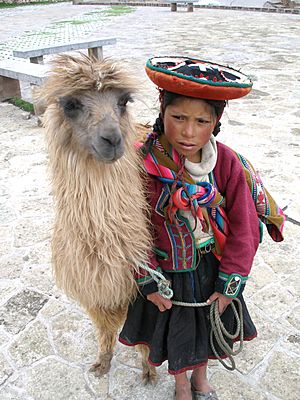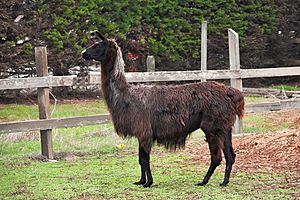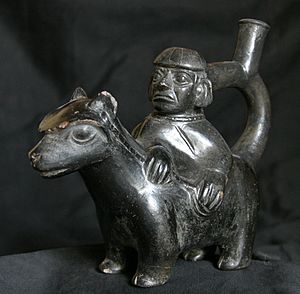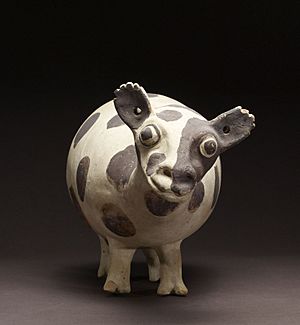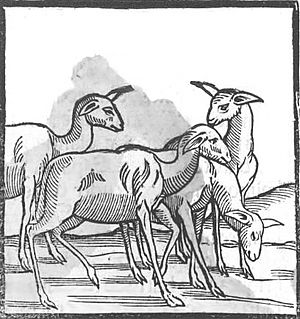Llama facts for kids
Quick facts for kids Llama |
|
|---|---|
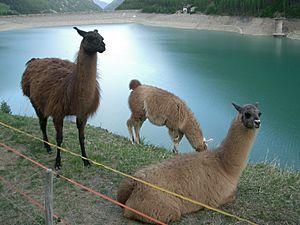 |
|
| Conservation status | |
| Scientific classification | |
 |
|
| Domestic llama and alpaca range | |
| Synonyms | |
|
Camelus glama Linnaeus, 1758 |
The llama (Lama glama) is a type of camel from South America that has been tamed by humans. For a very long time, people in the Andes Mountains have used llamas for their meat and to carry things. This started even before Europeans arrived in America.
Llamas love being with other llamas and live in groups called herds. Their wool is super soft and doesn't have much lanolin (a waxy substance found in sheep's wool). Llamas are smart and can learn simple tasks quickly. When they carry a pack, they can carry about 25% to 30% of their own body weight. They can walk with this load for 8 to 13 km (5–8 miles). The name llama comes from the native people of Peru.
Scientists believe that the ancestors of llamas first lived in the Great Plains of North America about 40 million years ago. They then moved to South America about three million years ago. By the end of the last ice age, about 10,000 to 12,000 years ago, camels had disappeared from North America. In 2007, there were over seven million llamas and alpacas in South America. There were also more than 158,000 llamas and 100,000 alpacas in the United States and Canada. These animals came from llamas brought over in the late 1900s.
In the old stories of the Aymara people, llamas are very important animals. They believed a Heavenly Llama drank water from the ocean and then rained it down. The Aymara also believed that at the end of time, llamas would return to the water springs and lagoons where they came from.
Contents
Llama Characteristics
A full-grown llama can be about 1.7 to 1.8 m (5 ft 7 in to 5 ft 11 in) tall at the top of its head. They can weigh between 130 and 272 kg (287 and 600 lb). Adult male llamas usually weigh around 95 kg, while females weigh about 102 kg. When a baby llama, called a cria, is born, it weighs between 9 and 14 kg (20 and 31 lb). Llamas typically live for 15 to 25 years, and some can even live for 30 years or more.
Llamas have some special features. Their ears are quite long and curve slightly inward, often called "banana" shaped. Unlike camels, llamas do not have a hump on their back. Their feet are narrow, and their toes are more separated than a camel's. Each toe has a soft pad underneath. Llamas have a short tail, and their fur is long, woolly, and soft.
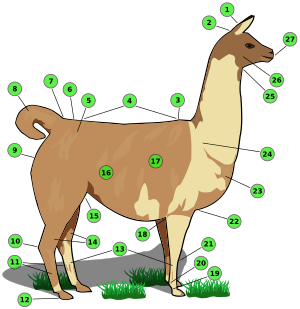
There are four main types of camel-like animals in South America. They are all very similar in how they look and act. Scientists sometimes debate if they are all one species or different ones. These four types are:
- the llama, Lama glama
- the alpaca, Vicugna pacos
- the guanaco, Lama guanicoe
- and the vicuña, Vicugna vicugna
Llamas and alpacas are only found as domesticated animals. They come in many colors like white, brown, or spotted. Some are grey or black. Guanacos and vicuñas live in the wild. Guanacos are light brown, turning white underneath. Vicuñas are smaller and thinner than guanacos. Vicuñas live in herds in the high, cold parts of the mountains, near areas of permanent snow. They are very watchful and shy.
Vicuña fiber is very fine and soft, making it valuable for weaving. Alpacas mainly come from wild vicuña ancestors. Domesticated llamas mostly come from wild guanaco ancestors. However, llamas and alpacas have also bred together quite a bit.
Llamas are bigger than alpacas and have longer heads and curved ears. Alpaca fiber is usually more expensive than llama fiber. Alpacas also tend to have a more consistent color all over their body. The easiest way to tell a llama from a camel is that camels have humps, and llamas do not.
Llamas are not true ruminants like cows or sheep. However, they do have a special three-part stomach. This stomach helps them digest tough, low-quality plants. The stomach allows them to ferment their food, then bring it back up to chew again. True ruminants have four stomach parts, but llamas only have three.
Llamas also have a very long and complex large intestine. The large intestine helps them take water, vitamins, and minerals from their food waste. Because their large intestine is so long, llamas can survive on much less water than other animals. This is a big help in the dry places where they live.
Llama Reproduction
A female llama, called a dam, carries her baby for about 11.5 months (350 days). When a baby llama is born, the mother does not lick it clean. This is because her tongue cannot reach far outside her mouth. Instead, she will nuzzle her newborn and make humming sounds.
A cria (which means "baby" in Spanish) is the name for a baby llama, alpaca, vicuña, or guanaco. When a cria is born, all the female llamas in the herd gather around. They do this to protect the newborn from male llamas and any possible predators. Llamas give birth while standing up. The birth is usually quick and easy, taking less than 30 minutes. Most births happen between 8 AM and noon, during the warmer parts of the day. This might help the baby llamas survive by preventing them from getting too cold during the chilly Andean nights. This birthing pattern is thought to be similar to how wild llamas give birth. Crias can stand, walk, and try to drink milk within an hour after being born.
Baby llamas drink their mother's milk. Llama milk has less fat and salt than cow or goat milk, but it has more phosphorus and calcium. A female llama only produces about 60 millilitres (2 US fluid ounces) of milk at a time. So, the cria needs to drink milk often to get all the nutrients it needs.
Llama Nutrition
There are many ways to feed llamas. You can use different types of commercial feeds or farm-grown foods. The best choice depends on the cost, what's available, and how much nutrition and energy the llama needs. Young llamas that are still growing need more nutrients than adult llamas. This is because their digestive systems are smaller.
| Body weight (lb) |
Bromgrass hay | Alfalfa hay | Corn silage | |||
|---|---|---|---|---|---|---|
| (as fed) | (dry matter) | (as fed) | (dry matter) | (as fed) | (dry matter) | |
| 22 | 0.8 | 0.7 | 0.5 | 0.5 | 1.5 | 0.4 |
| 44 | 1.3 | 1.1 | 0.9 | 0.8 | 2.6 | 0.7 |
| 88 | 2.1 | 1.9 | 1.5 | 1.3 | 4.3 | 1.2 |
| 110 | 2.6 | 2.3 | 1.7 | 1.6 | 5.2 | 1.4 |
| 165 | 3.4 | 3.1 | 2.3 | 2.1 | 6.9 | 1.9 |
| 275 | 5.0 | 4.5 | 3.4 | 3.1 | 10.1 | 2.8 |
| 385 | 6.4 | 5.7 | 4.3 | 3.9 | 12.9 | 3.6 |
| 495 | 7.8 | 7.0 | 5.3 | 4.8 | 15.8 | 4.4 |
| 550 | 8.5 | 7.6 | 5.7 | 5.2 | 17.0 | 4.8 |
Llama Behavior
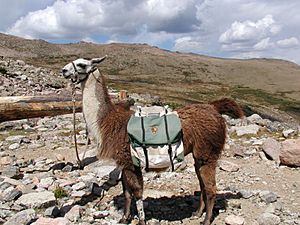
Llamas that are properly raised and trained are very friendly and nice to be around. They are very curious and will usually come close to people easily. However, if llamas are bottle-fed or handled too much when they are young, they can become difficult to manage as adults. They might start treating humans like other llamas, which means spitting, kicking, and neck wrestling.
Llamas have even started working in nursing homes and hospitals as certified therapy animals. For example, Rojo the Llama in the Pacific Northwest became certified in 2008. The Mayo Clinic says that animal-assisted therapy can help reduce pain, sadness, worry, and tiredness. This type of therapy is becoming more popular, and many groups across the United States are involved.
When llamas are raised correctly, they rarely spit at humans. But llamas are very social herd animals, and they do sometimes spit at each other. This is how they discipline lower-ranked llamas in the herd. A llama's social rank in a herd can always change. They can move up or down by having small fights. Males usually do this to see who will be in charge. Their fights look very dramatic, with spitting, chest-bumping, neck wrestling, and kicking to make the other lose balance. Female llamas usually only spit to control other herd members. You can tell how annoyed a llama is by what's in its spit. The more upset it is, the deeper it will try to pull material from its stomach for the spit.
Even though their social structure can change, llamas live like a family and take care of each other. If one llama hears a strange noise or feels threatened, it will make a loud, high-pitched alarm call. This sound rises and falls in a rhythm, and it makes all the other llamas alert. They also often hum to each other as a way of talking.
If a llama makes groaning noises or a "mwa" sound, it often means it's scared or angry. Unhappy or agitated llamas will lay their ears back. If their ears are perked up, it's a sign they are happy or curious.
Guard Behavior

People in North America started using llamas to guard livestock in the early 1980s. Some sheep farmers have used llamas successfully since then. They might even use them to guard their smaller relatives, the alpacas. Llamas are most often used in the western parts of the United States. This is where large predators like coyotes and wild dogs are common.
Using llamas as guards has helped many farmers lose fewer animals to predators. The value of the animals saved each year is much more than the cost of buying and caring for a llama. Not every llama is right for the job, but most are a good, non-harmful way to reduce attacks. They don't need special training and require little care.
Llama Fiber
Llamas have a fine undercoat of wool that can be used to make crafts and clothing. Their coarser outer guard hairs are used for things like rugs, wall hangings, and ropes. Llama fiber comes in many different colors. These colors range from white or grey to reddish-brown, brown, dark brown, and black.
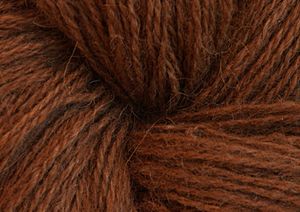
| Animal | Fiber thickness (micrometres) |
|---|---|
| Vicuña | 6–10 |
| Alpaca (Suri) | 10–15 |
| Muskox (Qiviut) | 11–13 |
| Merino sheep | 12–20 |
| Angora rabbit (Angora wool) | 13 |
| Cashmere goat (Cashmere wool) | 15–19 |
| Yak (Yak fiber) | 15–19 |
| Camel (Camel hair) | 16–25 |
| Guanaco | 16–18 |
| Llama (Tapada) | 20–30 |
| Chinchilla | 21 |
| Angora goat (Mohair) | 25–45 |
| Huacaya alpaca | 27.7 |
| Llama (Ccara) | 30–40 |
Medical Uses of Llamas
Doctors and researchers have found that llamas have special antibodies. These antibodies are very good at helping to treat certain diseases. Scientists have been studying how llamas might help fight coronaviruses. This includes viruses like MERS and SARS-CoV-2, which causes COVID-19.
History of Llama Domestication
Before the Inca Empire
One expert, Alex Chepstow-Lusty, believes that people were able to switch from hunting and gathering to widespread farming because they used llama dung as fertilizer.
The Moche culture often placed llamas or parts of llamas in the graves of important people. These were offerings or supplies for the afterlife. The Moche people, who lived in Peru before Columbus, made very realistic llama sculptures from clay.
The Inca Empire and Llamas
In the Inca Empire, llamas were the only animals used to carry heavy loads. Many of the groups of people conquered by the Inca had long traditions of herding llamas. For the Inca nobility, the llama was a very important symbol. Llama figures were often buried with the dead.
Today, in South America, llamas are still used to carry things. They are also raised for their fiber and meat.
The Inca god Urcuchillay was shown as a colorful llama.
Some historians believe that the large numbers of llamas in the southern Peruvian highlands helped the Inca Empire grow powerful. It's interesting that the largest area of the Inca Empire matched where most alpacas and llamas lived before Europeans arrived. The connection between the Andean mountains, llama herding, and the Inca state is still being studied.
Llamas and the Spanish Empire
When the Spanish conquered the Inca Empire, one of the main uses for llamas was to carry ore down from the mountain mines. One person, Gregory de Bolivar, estimated that 300,000 llamas were used just to transport goods from the Potosí mines. However, after the Spanish brought horses, mules, and donkeys, the llama's importance as a pack animal greatly decreased.
According to Juan Ignacio Molina, a Dutch captain named Joris van Spilbergen saw native Mapuche people using a type of llama called "hueques" to pull ploughs on Mocha Island in 1614.
In Chile, the number of hueques (llamas) dropped a lot in the 16th and 17th centuries. They were replaced by European livestock like sheep. The reasons for their decline are not fully clear. But it is known that introducing sheep caused some competition between the two types of animals. By the late 1700s, only the Mapuche people from Mariquina and Huequén were still raising these animals.
Llamas in the United States
Llamas were first brought to the US in the late 1800s to be shown in zoos. Rules about importing livestock from South America (because of diseases like hoof and mouth disease) and a lack of business interest kept the number of llamas low. This changed in the 1970s when people started to become interested in llamas as livestock. The number of llamas grew quickly as farmers bred more animals. Both the price and number of llamas in the US rose fast in the 1980s and 1990s.
Since there wasn't a big market for llama fiber or meat in the US, and the value of guard llamas was limited, the main reason to own llamas was to breed more of them. This is a classic sign of a speculative bubble in farming. By 2002, there were almost 145,000 llamas in the US, and some animals sold for as much as $220,000. However, because there was no real market for the animals in the end, both llama prices and the number of llamas crashed. The Great Recession also reduced money for investments. The number of llamas in the US began to drop as fewer were bred and older ones died. By 2017, the number of llamas in the US was below 40,000. A similar bubble happened with the closely related alpaca, which burst soon after the llama bubble.
Llamas in Culture
Llamas have always been important animals and cultural symbols in South America. More recently, they have also become popular in Western culture.
For example, the video game company Maxis has used llamas a lot in their games. They are especially featured in the very popular game series The Sims. Llamas are even the national symbol of the country where the broader series of Sim games are set. Also, the programming language Perl has been linked to llamas through its "Llama book".
See also
 In Spanish: Llama para niños
In Spanish: Llama para niños
- Alpaca
- Guanaco
- The Emperor's New Groove, a 2000 animated Disney film where an Incan emperor gets turned into a llama.
Images for kids


